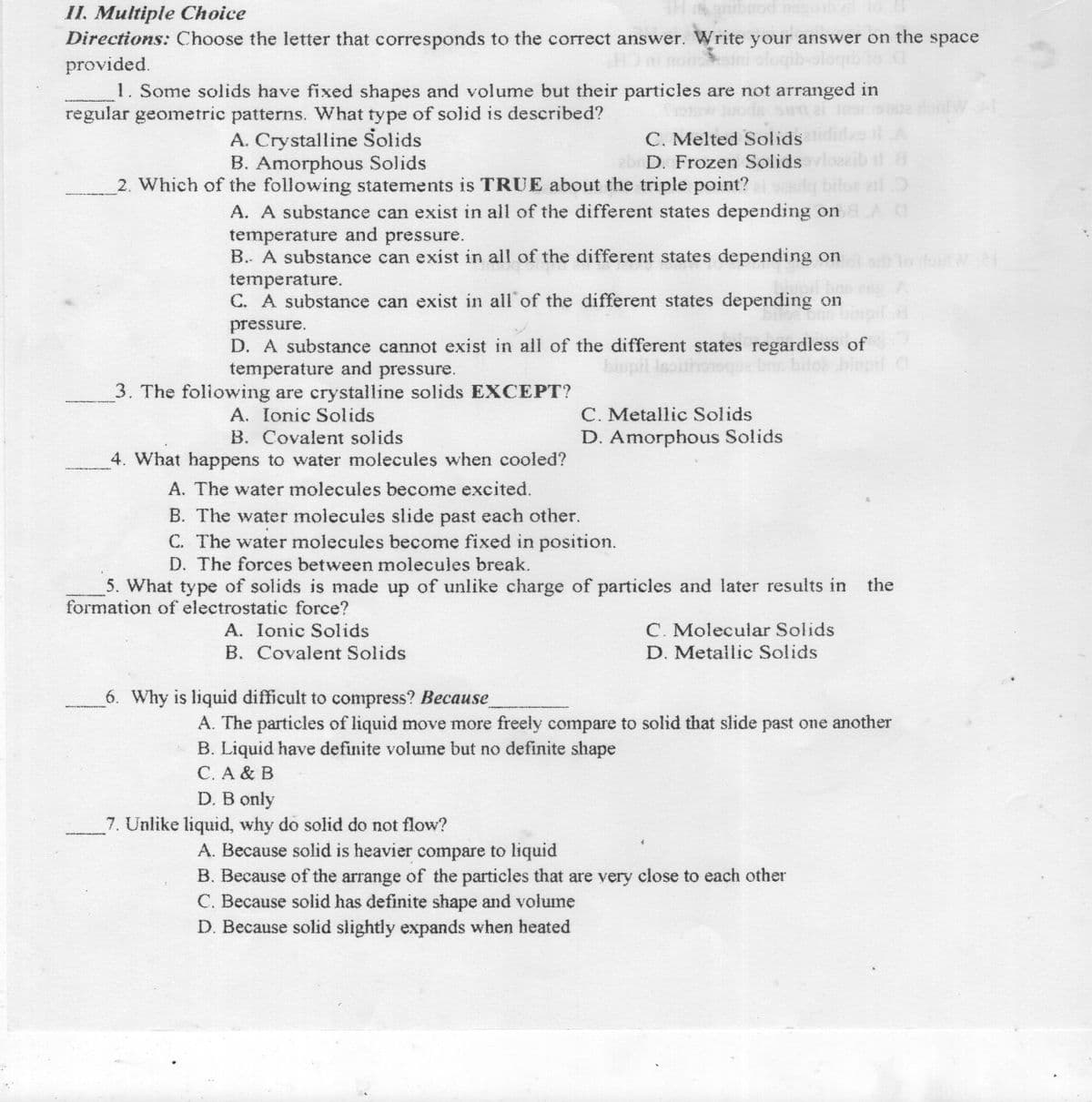1. Some solids have fixed shapes and volume but their particles are not arranged in regular geometric patterns. What type of solid is described? A. Crystalline Solids B. Amorphous Solids C. Melted Solids D. Frozen Solids 2. Which of the following statements is TRUE about the triple point? A. A substance can exist in all of the different states depending on temperature and pressure. B.. A substance can exist in all of the different states depending on temperature. C. A substance can exist in all of the different states depending on pressure. D. A substance cannot exist in all of the different states regardless of temperature and pressure. biupil isouhonque bs bilo binp 3. The foliowing are crystalline solids EXCEPT? A. Ionic Solids B. Covalent solids C. Metallic Solids D. Amorphous Solids
1. Some solids have fixed shapes and volume but their particles are not arranged in regular geometric patterns. What type of solid is described? A. Crystalline Solids B. Amorphous Solids C. Melted Solids D. Frozen Solids 2. Which of the following statements is TRUE about the triple point? A. A substance can exist in all of the different states depending on temperature and pressure. B.. A substance can exist in all of the different states depending on temperature. C. A substance can exist in all of the different states depending on pressure. D. A substance cannot exist in all of the different states regardless of temperature and pressure. biupil isouhonque bs bilo binp 3. The foliowing are crystalline solids EXCEPT? A. Ionic Solids B. Covalent solids C. Metallic Solids D. Amorphous Solids
Introductory Chemistry: A Foundation
9th Edition
ISBN:9781337399425
Author:Steven S. Zumdahl, Donald J. DeCoste
Publisher:Steven S. Zumdahl, Donald J. DeCoste
Chapter14: Liquids And Solids
Section: Chapter Questions
Problem 53AP
Related questions
Question
1-3

Transcribed Image Text:od nozob
II. Multiple Choice
Directions: Choose the letter that corresponds to the correct answer. Write your answer on the space
provided.
1. Some solids have fixed shapes and volume but their particles are not arranged in
regular geometric patterns. What type of solid is described?
DOLgibojo-qubo
Juoda sw ai or
C. Melted Solids
abr D. Frozen Solids
2. Which of the following statements is TRUE about the triple point?
A. Crystalline Solids
B. Amorphous Solids
ail
A. A substance can exist in all of the different states depending on AC
temperature and pressure.
B.. A substance can exist in all of the different states depending on
temperature.
C. A substance can exist in all of the different states depending on
pressure.
D. A substance cannot exist in all of the different states regardless of
temperature and pressure.
biupil is:
3. The foliowing are crystalline solids EXCEPT?
C. Metallic Solids
A. Ionic Solids
B. Covalent solids
D. Amorphous Solids
4. What happens to water molecules when cooled?
A. The water molecules become excited.
B. The water molecules slide past each other.
C. The water molecules become fixed in position.
D. The forces between molecules break.
5. What type of solids is made up of unlike charge of particles and later results in
formation of electrostatic force?
the
C. Molecular Solids
A. Ionic Solids
B. Covalent Solids
D. Metallic Solids
6. Why is liquid difficult to compress? Because
A. The particles of liquid move more freely compare to solid that slide past one another
B. Liquid have definite volume but no definite shape
C. A & B
D. B only
7. Unlike liquid, why do solid do not flow?
A. Because solid is heavier compare to liquid
B. Because of the arrange of the particles that are very close to each other
C. Because solid has definite shape and volume
D. Because solid slightly expands when heated
Expert Solution
This question has been solved!
Explore an expertly crafted, step-by-step solution for a thorough understanding of key concepts.
This is a popular solution!
Trending now
This is a popular solution!
Step by step
Solved in 2 steps with 3 images

Knowledge Booster
Learn more about
Need a deep-dive on the concept behind this application? Look no further. Learn more about this topic, chemistry and related others by exploring similar questions and additional content below.Recommended textbooks for you

Introductory Chemistry: A Foundation
Chemistry
ISBN:
9781337399425
Author:
Steven S. Zumdahl, Donald J. DeCoste
Publisher:
Cengage Learning

World of Chemistry, 3rd edition
Chemistry
ISBN:
9781133109655
Author:
Steven S. Zumdahl, Susan L. Zumdahl, Donald J. DeCoste
Publisher:
Brooks / Cole / Cengage Learning

Chemistry & Chemical Reactivity
Chemistry
ISBN:
9781337399074
Author:
John C. Kotz, Paul M. Treichel, John Townsend, David Treichel
Publisher:
Cengage Learning

Introductory Chemistry: A Foundation
Chemistry
ISBN:
9781337399425
Author:
Steven S. Zumdahl, Donald J. DeCoste
Publisher:
Cengage Learning

World of Chemistry, 3rd edition
Chemistry
ISBN:
9781133109655
Author:
Steven S. Zumdahl, Susan L. Zumdahl, Donald J. DeCoste
Publisher:
Brooks / Cole / Cengage Learning

Chemistry & Chemical Reactivity
Chemistry
ISBN:
9781337399074
Author:
John C. Kotz, Paul M. Treichel, John Townsend, David Treichel
Publisher:
Cengage Learning

Chemistry & Chemical Reactivity
Chemistry
ISBN:
9781133949640
Author:
John C. Kotz, Paul M. Treichel, John Townsend, David Treichel
Publisher:
Cengage Learning

Principles of Modern Chemistry
Chemistry
ISBN:
9781305079113
Author:
David W. Oxtoby, H. Pat Gillis, Laurie J. Butler
Publisher:
Cengage Learning

Introductory Chemistry: An Active Learning Approa…
Chemistry
ISBN:
9781305079250
Author:
Mark S. Cracolice, Ed Peters
Publisher:
Cengage Learning